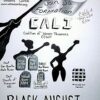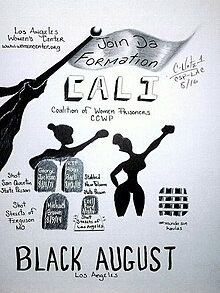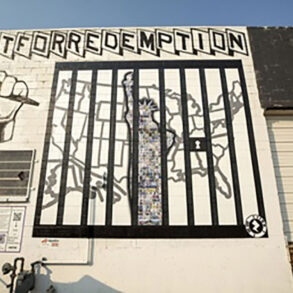“Celebrating Black Women Through Art,” is a retrospective look at the visual exalting of Black women by American prison-artist C-Note.
Celebrating Famous Black Women Through Art
In 2001, Hip Hop icon Eve dropped her first single “Who’s That Girl,” From her second studio album Scorpion. Eight years later, California prisoner Donald “C-Note” Hooker would draw his first opus to Black women, Colored Girl.
In 2009, there was no Black Twitter, Instagram nor Snapchat, and Facebook was not a publicly traded company. The year prior, saw the final episode of the UPN, all Black female cast, Girlfriends. The visibility of Black female empowerment and Beauty as we know it today in 2022, did not exist in 2009.
In 2009, the Bible on Black male incarceration, Michele Alexander’s The New Jim Crow: Mass Incarceration in the Age of Colorblindness had yet to be published, and there was no Black Lives Matter movement. The prevailing view Black women had towards incarcerated Black men was nearly identical to the Black community as a whole, at that time, they were viewed as pariahs.
On top of that, he had already spent ten years at a prison the Associated Press would report, “Guards at an isolated state prison have created a “culture of racism,” engage in alarming use of force against inmates and have a code of silence encouraged by the union that represents most corrections officers.”
Aljazeera America reported on an investigation that discovered a culture of racism and lack of acceptance of ethnic differences. “Just 18 percent of the prison’s inmates are white, compared with 74 percent of guards and 89 percent of supervisors,” citing an Inspector General report.
In an Inspector General interview with one former prisoner, “Blacks were treated very differently. They are on lockdowns a lot longer; they go to the hole for the smallest of reasons; and officers mess with their food,” reported Aljazeera America.
Deep in the Sierra-Nevada Mountain range, the report says, some problems at the High Desert facility evolved because the prison is so isolated about 90 miles northwest of Reno, Nevada. It is also the sighting of Bigfoot.
2009 represented a time in C-Note’s life of extreme isolation, and being Black was highly traumatic. Yet in the midst of the ugly, he mustered the fortitude to give the world Colored Girl. In a 2016 interview with Darealprisonart he describes the piece:
DRPA: Now we asked you to bring some art, you initially only brought two pieces, and then went back and grabbed four more, why was that?
C-Note: Well, I thought about it, and these other pieces would add to the richness of the conversation and let you know what kind of work I do and how I utilize these works.
DRPA: So what piece would you like to start off with first?
C-Note: “Colored Girl (Highlighted)“
DRPA: I notice it’s a print, and it’s called “Highlighted,” does that mean there is more to this piece?
C-Note: Yes, I still have the original that I hope to give and have exhibited in the National Museum of African American History and Culture, on the National Mall, in Washington D.C.. It’s a very significant piece, for one, it’s a very beautiful piece. It is a piece, and its beauty was made by accident. In other words, I have no clue how it came about. I work in a medium that doesn’t get recognized, I work in wax. So I put all this different kind of wax together and different formulae to dissolve the wax on paper. I had a model. A picture out of a magazine. But I’m not confident as an artist so I don’t want people to compare my finished product to the model or image that I used. I called it “Colored Girl.” I think it fits. It’s clearly a coloration of something, of a woman. But the word “Colored,” though it is a pejorative today, was once known as the desired description that African Americans prefer to be described as. “Colored,” “Negro,” “Black,” these were all terms that African-Americans themselves demanded of the press and white audiences; this is what you call us. An example would be W. E. B. Dubois NAACP. It was originally called the National Negro Committee. Booker T. Washington and other famous black activists before him, demanded that whites call us “Negroes.” So three years after founding the National Negro Committee, W. E. B. Dubois changed the name to the National Association for the Advancement of Colored People. That’s proof enough that blacks demanded that they be called “Colored.” So “Colored Girl,” what is that? Any black girl, and that’s pretty much the response that I have gotten from this piece. It’s funny because I used a famous person for this piece, but for my own insecurities I never named the person in this piece and all sorts of blacks swear on a stack of Bibles they know who this person is. I hear the names “Vanessa Williams,” “Janet Jackson,” “Eva Pigford,” all across the spectrum. When blacks see the piece, when I show the original, they just get animated. They just light up. There is this spiritual thing that goes on, we begin to communicate telepathically with one another. African Americans have a general complaint that there is a dearth of positive images of them, so there is this silent communication between me and others that this is what that is. So an accidental discovery, “the piece,” and the title, does what it is intended to do, any “Colored Girl.”
DRPA: Wow, that’s quite a story there.
C-Note: Ah, but it’s just one.
Now you know why we made reference to Eve’s “Who’s That Girl,” as everyone wants to know, “Who is the famous celebrity behind Colored Girl?”
Mona Lisa
In 1962, Pop Art icon Andy Warhol created a series of retrospective Works to the Mona Lisa of the twentieth century, Marilyn Monroe. Monday, August 6th, 1962, was the first time East Coast newsprint publications could report on the Saturday, August 4th, 1962, discovery of Marilyn Monroe’s fatal overdose. That Monday was also the 34th birthday of Manhattan, New York City, New York resident, Andy Warhol. The debate of Warhol’s seeming obsession over Marilyn Monroe as depicted in these paintings is ongoing. One artist pushes back over critics’ pronunciation that Warhol’s intentions were purely commercial.
“The tragic death of a larger-than-life woman driven to Suicide was not a moment of celebration for an artist who had feelings, like Warhol. She would not be remembered like that, and so Warhol immortalized her at age 26, not 36, the age of her death. He used a single publicity photo from her 1953 film Niagara. Warhol’s portrayal of Monroe serves as the Mona Lisa of our Era,” articulates American prison artist C-Note.
C-Note ought to know. In 2015 he created his Warhol inspired work Colored Girl Warholed. It is fashioned after Warhol’s Four Marilyns. C-Note’s Colored Girl Warholed uses his 2009 work Colored Girl. Prints of Colored Girl Warholed went on sale in the spring of 2015. In the fall of 2015, the auction house Christie’s sold Warhol’s Four Marilyns for $36 million.
Anna D. Smith’s “Look Up!” 2, Hope and Beauty Billboard Art Exhibition and Art Sale Dec 27 – Jan 31, 2022:
In the winter of 2021, Fine Art and Real Estate Broker, Anna D. Smith curated C-Note’s Colored Girl Warholed as an outdoor art exhibition, Anna D. Smith’s ‘Look Up!’ 2 Hope & Beauty Billboard Art Exhibition and Art Sale, Dec 27 – Jan 31, 2022.
In several interviews, Smith states:
“
I correspond with Donald “C-Note” Hooker and I started to admire his intellect and Art as we continued to write to one another.
I thought that his Art would make a unique contribution to my vision of Hope and Beauty in Silicon Valley and the Bay Area.
I wanted to have the Art of a powerful and soulful man to exhibit my theme therefore I am advocating for prison artist Donald “C-Note” Hooker.
It seems to me that the culture of discontent is claiming our innocence and more likely to be exploited rather than elevated.
Despite Breanna Taylor, Valentina Orellana-Peralta, #MeToo, #SayHerName, C-Note’s Art reminds us we are all grandmothers, mothers, other mothers, daughters, sisters, aunts, nieces, and have Beauty and Dignity.
Nevertheless, Anna D. Smith’s “Look Up!” 2 Hope & Beauty Billboard Art Exhibition was absolutely necessary in these two + years of trying times of uncertainty and social isolation for all of Humankind. I was able to create two Art Events with C-Note’s help, and I’m joyful about this!
The exhibition is in Santana Row. A residential and retail District in San Jose, California. San Jose is the largest city in Silicon Valley, the Tech capital of the world.
Santana Row is the home to premiere restaurants, residential, and retail. It allows for one-million daily Billboard Art Exhibition views. Google, Facebook, and Apple workers live in Santana Row. Tesla has a showroom in Santana Row, and Sports teams stay at the Valencia Hotel in Santana Row.
Celebrating the Black Queen Through Art
In the winter of 2019, C-Note was invited to participate in the 30th Annual Celebration of African American Poets and Their Poetry, in Oakland, California. One of the event’s poetry theme prompts was the “400 Years of California, African American History.” Upon research, C-Note had discovered that Spanish conquistador, and Governor of Mexico, Hernán Cortés, named California after a Black woman, the Califia (Queen) to the land of Black women.
The poem, Journey to Afrofuturism, brings back the Califia to our current times, as the nursemaid to the Afrofuturism movement. When Wanda Sabir, the curator of the annual poetry event, planned on publishing a book on the 30-years of the event, this spurred C-Note to create a visual work of art to his poem. The drawing bears the same name as the poem.
Speculative City Magazine paid C-Note for both the poem and drawing to be published in their Winter of 2020, Issue #10, Afrofuturism.
In the fall of 2021, both the Journey to Afrofuturism poem and drawing were recited and exhibited at the University of California, Santa Cruz (UCSC), Zoom event, Afrofuturism Then and Now. The event was the inaugural 2021 – 2022 Academic Year Global discussion and performances on what Afrofuturism means and how it manifests in cultural practices. The Zoom call panelists consisted of speakers in diverse locations such as the Congo in Central Africa, Burkina Faso in West Africa, and several cities in the Northern California Bay Area in the United States. The event concluded with Hip Hop artist and Hip Hop Congress Board Chairman Rahman Jamaal exhibiting and reciting C-Note’s artwork and poem Journey to Afrofuturism.
Celebrating Black Mothers Through Art
Dreams of the Mothers, circa 2010s, Wax on paper. Dreams of the Mothers was a work that was begun during the 2000s; however, it had sat unworked for years. In the interim, the prison artist would finish a work he would call Dreams of the Fathers.
Dreams of the Mothers was one of the Works featured in C-Note’s 2015, Prison Cell Art Gallery, and was a part of the 2016 Escaping Time, Prisoner Art Exhibit, on Governors Island, New York City, New York, July 26 – Oct 2, 2016.
Dreams of the Mothers is also the cover art to C-Note’s 2018 epic poem, Can’t Black Lives Matter Too???. Technically, Dreams of the Mothers would be difficult for any artist, as it depicts a picture within a picture.
Celebrating Black Muslim Women Through Art
Da Muslima (The Muslim woman), circa 2000s, is a mixed media of Wax and ink on paper. The work has two points of inspiration, one is the highlighting of the African American Muslim in the United States, and the other is Johannes Vermeer’s Girl with a Pearl Earring. The use of the white headwrap as a highlight of this Work was inspired by Vermeer, as well as the earring highlighted by its shadow.
Celebrating the Black Woman Through Fashion
In 2019 – 2020 C-Note worked with Fashion designer Makenzie Stiles for her fashion line Mercy. COVID-19 lockdowns in the Spring of 2020 prevented a global first in the 100-year-plus history of the Catwalk, models walking the Runway in clothes designed with Prison art.
In December of 2021, C-Note and his artwork Decarcerate Now! was included in the Black Fashion World Foundation’s virtual, The Mask Parade Show. Also look for C-Note in Black Fashion World Foundation’s COVID Mask collectible coffee table book.
Black Fashion World Foundation was founded in 2017 by African American Fashion entrepreneur Carla Nelson. Its purpose is to empower black fashion professionals, [“black fashion-preneurs”]. BFW Foundation’s mission, is to serve an important role in society by creating an economic stimulus; unity in the black culture; investment in the welfare of others; a reduction in crime; and an overall improvement in the quality of life for “black fashion-preneurs” and the African American community as a whole. By working with and assisting “black fashion-preneurs”, BFW Foundation creates opportunities for employment, assists with business creation, and promotes economic sustainability in the fashion industry. BFW Foundation is a 501(c)3 non-profit.
Celebrating Young Black Women Through Art
Brittany, 2018, is a work of Wax on paper. It is a work that illustrates that to be Black in the Americas can come from all hues.
Celebrating Sexy Black Women Through Art
Coffee Bar, 2017, a work of Mixed-medium on paper, could have been the cover art to Megan Thee Stallion’s 2019 “Hot Girl Summer.” Instead, this visual double entendre was part of the Everything Coffee, Prison Art exhibition. The event was curated by Treacy Ziegler of Prisoner Express. The exhibition consisted of two shows; one in January of 2018 at Gimme Coffee’s Cayuga Street coffeehouse in Ithaca, New York; the other in March of 2018 at Gimme Coffee in Trumansburg, New York.
Prison artists were tasked with using coffee as their visual medium, and curators were not looking for commercial works of steaming cups of coffee. In Coffee Bar, C-Note uses instant coffee as the base medium for the ice cream bar; while watercolor was sporadically used for highlights and lowlights, and floor wax was used as a glaze. The medium used for the woman was wax.
Celebrating the Nude Black Woman Through Art
This Untitled work which began in the 2010s, has sat unworked on for years. Yet it illustrates his use of contour to exemplify the gracefulness of the feminine form.
Conclusion
In the world of emerging artists, no other artists have changed lives, saved lives, raised millions of dollars, made history in the Fashion world, and had two billboard art exhibitions. More than just an award-winning visual artist, Donald “C-Note” Hooker is a poet, playwright, and Performing Artist. His Works have either been exhibited, recited, performed, or sold, from Alcatraz to Berlin.
His 2018, 700-plus word epic poem, Can’t Black Lives Matter Too???, ends with the Alabama rape in 1944 of Recy Taylor by six young White men.
In 2017, his abstract “THE IMPORTANCE OF WOMEN VOICES IN STRUGGLE: Emphasis on the Black Woman’s Voice,” tells us how reading the autobiographies of former members of the Black Panther Party, Angela Davis and Elaine Brown, informed him of the patriarchy within Black movements for freedom and equality.
His 2018, 700-plus word epic poem It Must End! (BLACK FEMALE BOYCOTTS AGAINST BLACK MEN IN THE PEN) he warns of a pending calamity within the Black community, as more and more Black male prisoners are turning to psychotropic medications to cope with the collective alienation they get from the Black female.
In his role as the keeper of Hip Hop’s historical traditions from behind-the-wall, C-Note tells us of “The Miseducation of Armani G.” The 19 year old Flint, Michigan, female rap-phenom, who struggled with homelessness, literacy, and a father who was in prison.
Writing for Music Magazine, “‘Savage’ Brings The End Of Men,” C-Note tells us Megan Thee Stallion’s 2020 best Hip Hop Video Award over five male artists at the 36th annual MTV Video Music Awards:
“Like Chaka Khan’s 1970 hit, ‘I’m Every Woman,’ ‘Savage’ is a lyrical tour-de-force espousing feminine prowess unmatched for mere mortal men. The reason why ‘Savage’ slayed the men, it’s the 21st century version of ‘I’m Every Woman.’”
In a 2020 Muzique Magazine interview “How Female Mc’s Have An Advocate In The King Of Prison Hip Hop,” it begins:
MM: We’ve noticed you write about women artists.
C-Note: I love women. I think they have important things to say. I don’t write as a Critic, I write as an advocate, informing the public they need to hear what this person has to say. I’ve ghostwritten articles on teenage Australian rapper Nina Lee Kisses on her rap song Pink Pantha. If you love Biggie Smalls not as a drug dealer, but as a criminal assassin, and if you love Kylie Jenner, then you’ll love this song.
Despite his visual and literal history, to date, C-Note has never been written about in any mainstream art publication. Without recognition from mainstream art publications, C-Note will be unable to transition from an emerging artist to a mid-career artist, then to an established artist, where prints of his works are projected to sell at $150,000 per print, rather than the $5,000 that they sell for now.
According to Contemporary Art consultant Allan Schwartzman, with over 40 years in the Contemporary Art Market, works by African American artists are the most sought-after art. However he cautions, it is the hardest to get to.
What kind of visibility do women have in the established art World, let alone Black women? Despite the “White” establishment, kind of pronouncements of reparations in the art world after the death of George Floyd, as long as artists are working in underground art scenes, they are ignored.
We hope you enjoyed this retrospective look at one of the most important emerging contemporary artists in the underground art scene.
Bonus
Droning the Look Up! 2 Art Exhibition | YouTube
Wanna join C-Note’s fan club???
Just take a photo with you next to his work and send it to us. To learn more about C-Note visit his website www.c-note.org or to send him donations for art supplies or prison commissary (food), click on the Jail Pay link, J-Pay.
This post was originally published on this site be sure to check out more of their content








